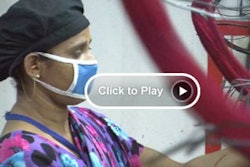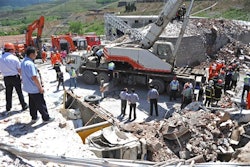Equipment downtime, lost production, delays in product reviews and high travel costs to troubleshoot problems can kill the bottom line. Time is money and it’s never been truer for companies with operations spread across the globe. When the best expert is located in New York and the assembly line is in the Far East, costs mount quickly when decisions are delayed. With virtual presence systems, no one leaves their desk, let alone the country.
Virtual presence brings the problem to the expert, rather than the other way around. These systems generally include collaboration software for smartphones, tablets and desktops as well as hardened wireless video devices for tough environments. Plant workers use the mobile device to share video, voice, telestration (i.e., onscreen drawing) and images with the experts who interact live through the collaboration software. Remote experts can also share images or pre-recorded videos to play on the touchscreen panel of the device.
By sharing this visual content, the experts can provide plant floor personnel or field technicians with visual instructions. The system can be used virtually anywhere as it connects with wireless, satellite and cellular networks.
Virtual Presence Equipment
There are a number of approaches to building a virtual presence mobile system.
The system is comprised of three main components:
- Collaboration software that runs on the tablets, smartphones and computers;
- Specialized wireless video devices (cameras); and
- Management software that provides system administrators with centralized management tools for their system.
Reduced Downtime
Mobile collaboration helps in various operational situations, including production line equipment maintenance and repair, supply chain interaction, and OEM vendor communication.
By using the mobile video device to show a remote expert the failed equipment, manufacturers remove costly delays from the repair process. Together, the production line engineer and remote specialist can now collaborate to identify immediate corrective action plans.
Improved Vendor Interaction
CPG manufacturers use mobile collaboration to streamline supply chain interaction. Normally, in performing acceptance test processes, team members travel to the supplier locations for live interactions, introducing delays into the process. Instead of travel, the mobile devices are now kept or shipped to major suppliers to perform live visual communication when needed. The camera optics within these mobile devices are so advanced that remote experts can see detailed design aspects where even a fraction of a millimeter matters.
Secure Mobile Video
For many manufacturers, their plant floor operation contains competitive sensitive information; for this reason, cameras are typically not allowed on the plant floor. New mobile devices overcome that concern by providing tight security over the wireless communication, media content and device usage. Security, encryption, authentication and even centralized administrator control have become tablestakes for mobile virtual presence technologies.
Network Requirements
The main requirement is access to the Internet in the field or within a facility. Internet access can be achieved using a wireless, cellular or satellite network. Wireless connectivity (i.e., 802.11 b/g/n) is the most common method used at a manufacturing plant, while 3G or 4G cellular networks are commonly used in the field. For specialized devices that require either an Ethernet or wireless connection, mobile Wi-Fi hotspot devices can create local wireless networks using 3G or 4G cellular.
Extend Existing Video Infrastructure
Virtual presence systems integrate with industry standard video conferencing equipment to leverage existing investments in this infrastructure. In addition to standard video rooms, content can also be shared with multiple experts simultaneously on the desktop computers, smartphones or tablets.
Case Study: Sub-Zero Inc.
Sub-Zero Inc, the leading manufacturer of luxury refrigeration and wine preservation systems revolutionized kitchen design by pioneering the development of the built-in refrigerator in the 1950s. The company is still family owned and committed to maintain its manufacturing facilities in American, namely Wisconsin and Arizona. It now has an established global sales network that brings Sub-Zero and Wolf appliances to the best in kitchen around the world.
Sub-Zero continually seeks ways to improve their manufacturing systems with advanced technology and process improvements. Mark Swartz, Director of Corporate Quality, explained, “At Sub-Zero, we follow a forward quality process as opposed to a reactive quality process. This approach means that we eliminate or mitigate quality issues far in advance, which takes careful planning, rigorous attention, strong supplier management and innovative technologies.”
In the past, there was no mobile video collaboration system to use with colleagues or suppliers to speed and improve decisions. Now, Sub-Zero connects experts in their Wisconsin facilities with colleagues in Arizona, and global suppliers or vendors in live video collaboration sessions that are fully secure and include high quality video, voice, onscreen mark-up and image sharing.
When Sub-Zero undertook an aggressive expansion of their Integrated Refrigeration product line, they needed a new approach to collaboration. The expansion project involved the development of new models and building a greenfield manufacturing facility in Arizona.
One of the core team members, Arturo Bonomie, a Senior Design Engineer at Sub-Zero, is responsible for the project’s mobile video collaboration system. The company initially tried using consumer grade video collaboration software on their computers and phones to connect between locations. This method proved ineffective for a host of reasons. Arturo explained, “We needed a way to see and discuss very detailed video and images from afar in a highly secure manner. We also needed a way to collaborate across locations without having to be physically together or inside a video meeting room.”
Sub-Zero found many beneficial applications of mobile video collaboration. One of the applications involves the team’s weekly quality update meeting with people in the Corporate Development Lab in Wisconsin and the new manufacturing facility in Arizona. The Librestream system is included in every weekly meeting to help show and discuss cabinet design issues or troubleshoot production line tools across locations.
Arturo added, “We can now show the latest prototypes to colleagues across facilities using Librestream’s devices and collaboration software. We can see amazing up-close detail, which allow us to see if there is even the slightest surface indent or if a hole is just slightly off center. We talk, freeze the video and draw both ways to bring attention to these slight imperfections immediately. We can even take pictures and record the sessions for future review and comparison during later review meetings. ”
In the final step of quality control, Sub-Zero field tests the new models in customer homes to review performance across different environmental conditions. Typically this process involves multiple engineers travelling to the customer home.
“Instead of sending three or four engineers to our customer field tests, we can now send one engineer and bring the rest of the team in via the Onsight system. The engineer can even run Onsight on an iPad or iPhone through a cellular connection. The other participants can be in the office or even working from home.”
This translates into direct cost savings and perhaps more importantly, shrinks the time required to make design adjustments, accelerating our delivery of new products to the market,” confirmed Arturo.
With the advent of mobile technologies, manufacturers have proven that secure mobile video helps reduce downtime, drive quality improvements, accelerate product delivery, leverage experts and eliminate unnecessary travel. Now, for many manufacturers, engaging in a video collaboration session has become as simple as making a phone call.
For more information, visit www.librestream.com.























